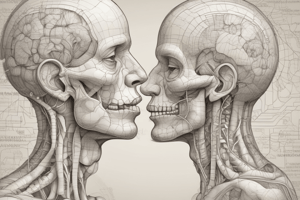Podcast
Questions and Answers
What are the primary components of the external structure of the nose?
What are the primary components of the external structure of the nose?
- Olfactory bulb and cilia
- Nasal cavity and septum
- Respiratory system and mucous glands
- Bridge, tip, and nostrils (correct)
What role does the nasal cavity play in respiration?
What role does the nasal cavity play in respiration?
- Stores scent messages for retrieval
- Controls the speed of speech
- Filters and warms incoming air (correct)
- Regulates the production of mucus
Which condition is characterized by inflammation of the nasal mucosa?
Which condition is characterized by inflammation of the nasal mucosa?
- Rhinitis (correct)
- Nasal polyps
- Olfactory dysfunction
- Sinusitis
How does the nose contribute to the quality of voice and resonance?
How does the nose contribute to the quality of voice and resonance?
What is a recommended health tip for maintaining nasal health?
What is a recommended health tip for maintaining nasal health?
Flashcards
External Nasal Structure
External Nasal Structure
External part of the nose composed of the bridge, tip, and nares. Supported by cartilage and covered by skin.
Nose's Role in Respiration
Nose's Role in Respiration
Warms and humidifies incoming air, and filters particles and pathogens using mucus and cilia.
Rhinitis
Rhinitis
Inflammation of the nasal mucosa, often caused by allergies or infections.
Resonance
Resonance
Signup and view all the flashcards
Nasal Polyps
Nasal Polyps
Signup and view all the flashcards
Study Notes
Anatomy of the Nose
-
External Structure:
- Consists of the bridge, tip, and two nostrils (nares).
- Covered by skin and contains cartilage for shape.
-
Internal Structure:
- Nasal cavity divided into two halves by the nasal septum.
- Lined with mucous membrane containing cilia and goblet cells.
Functions of the Nose
-
Respiration:
- Warms and humidifies incoming air.
- Filters particles and pathogens through mucus and cilia.
-
Olfaction:
- Houses olfactory receptors for the sense of smell.
- Olfactory bulb processes scent information.
-
Resonance:
- Contributes to voice quality and resonance during speech.
Common Conditions
- Rhinitis: Inflammation of nasal mucosa, often due to allergies or infections.
- Sinusitis: Inflammation of sinuses, leading to congestion, pain, and pressure.
- Nasal Polyps: Noncancerous growths in the nasal lining, often associated with chronic inflammation.
Nose Health Tips
- Maintain good hygiene by regularly cleaning nasal passages.
- Stay hydrated to keep mucous membranes moist.
- Use saline nasal sprays to relieve congestion.
- Avoid irritants such as smoke and strong odors.
Anatomy of the Nose
- The external structure includes the bridge, tip, and two nostrils (nares), which are supported by cartilage and covered by skin.
- The internal structure consists of a nasal cavity divided by the nasal septum into two halves.
- The nasal cavity is lined with mucous membrane that features cilia and goblet cells for mucus production.
Functions of the Nose
- Respiration:
- Warms and humidifies the air as it enters the body.
- Filters out particles and pathogens using mucus and cilia.
- Olfaction:
- Contains olfactory receptors critical for the sense of smell.
- The olfactory bulb processes and interprets scent information.
- Resonance:
- Affects voice quality and resonance, enhancing speech.
Common Conditions
- Rhinitis:
- Involves inflammation of the nasal mucosa, commonly triggered by allergies or infections.
- Sinusitis:
- Inflammation of the sinuses that causes congestion, pain, and pressure in the face.
- Nasal Polyps:
- Noncancerous growths found in the nasal lining, often linked to chronic inflammation.
Nose Health Tips
- Maintain good hygiene by cleaning nasal passages regularly to prevent infections.
- Stay hydrated to ensure that mucous membranes remain moist and effective.
- Use saline nasal sprays to alleviate congestion and keep nasal passages clear.
- Avoid irritants like smoke and strong odors that can cause nasal irritation.
Studying That Suits You
Use AI to generate personalized quizzes and flashcards to suit your learning preferences.




